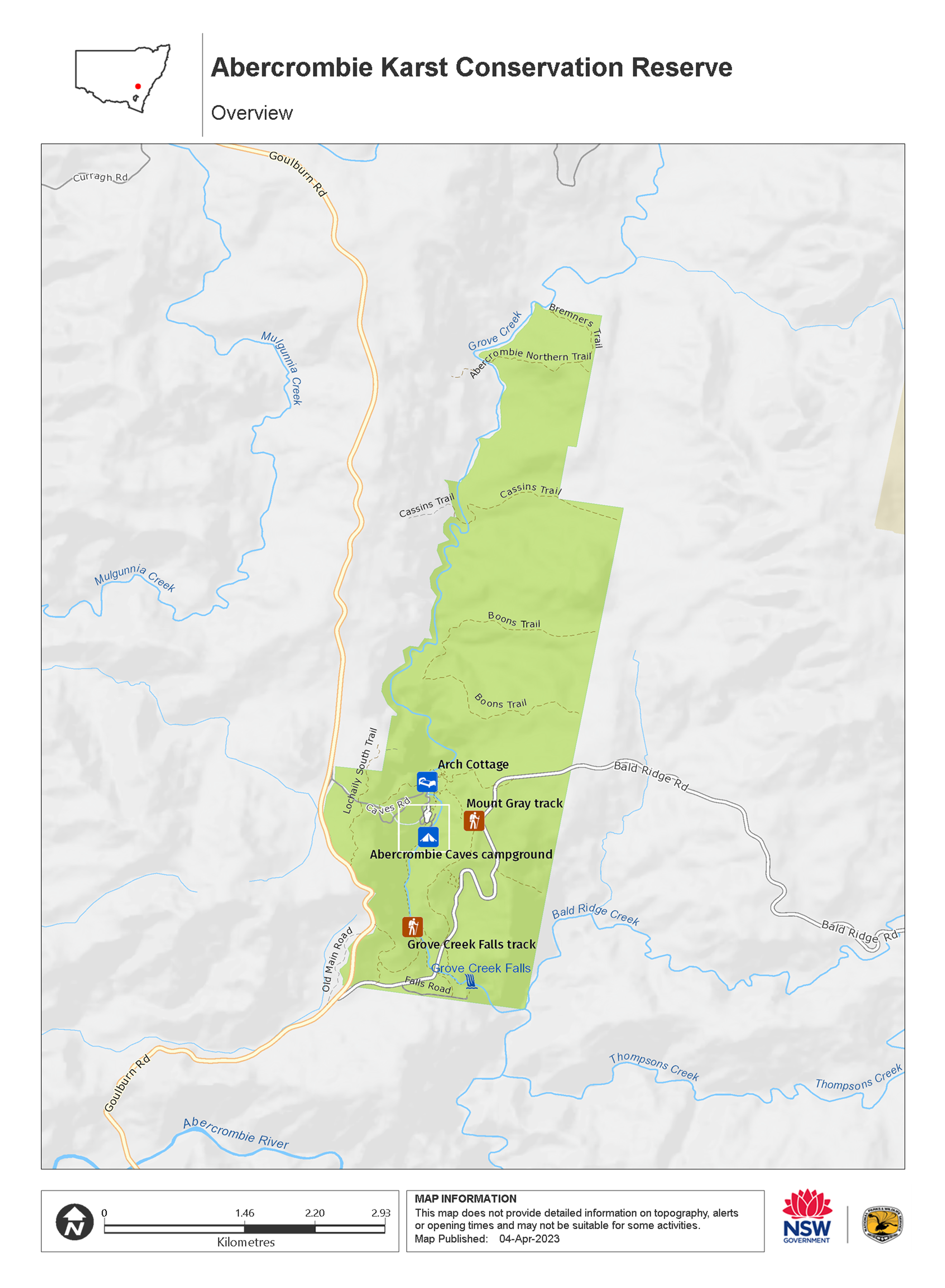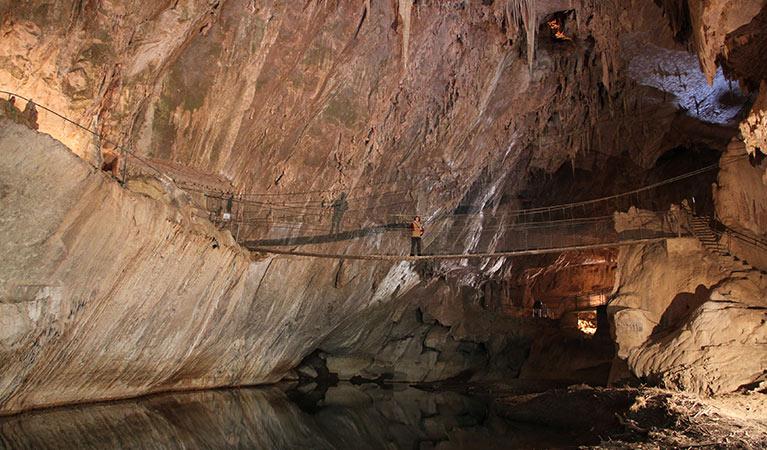Abercrombie Karst Conservation Reserve
Abercrombie Karst Conservation Reserve closed
Abercrombie Karst Conservation Reserve is closed until late September 2025. We're working to ensure safe access for visitors and repair flood damage to caves, walking tracks, the campground and accommodation.
Overview
Abercrombie Karst Conservation Reserve is closed until late September 2025. We're working to ensure safe access for visitors and repair flood damage to caves, walking tracks, the campground and accommodation.
Read more about Abercrombie Karst Conservation Reserve
Famous for its incredible limestone caves, Abercrombie Karst Conservation Reserve offers great bushwalking, waterfalls and picturesque camping for the whole family. An Abercrombie Caves tour is an unforgettable experience.
Set in a peaceful valley, Abercrombie Karst Conservation Reserve is a spectacular place to visit and a unique opportunity to experience the hidden depths of NSW. Abercrombie Caves boasts the largest natural arch in the southern hemisphere, as well as a number of other grand, richly decorated caves. Take the kids on a cave tour and go on a magical underground journey.
With so much to do and see, why not stay overnight? Enjoy a night by the campfire at Ambercrombie Caves campground, or cosy cabins and open fireplaces at Arch Cottage.
Make your way along Mount Gray walking track to see the historical relics of an old gold-mining community from the 1880s. Pack a picnic, walk to the magnificent Grove Creek Falls and take in the dramatic views. This is a great place to catch a memorable photograph and enjoy a refreshing swim surrounded by bush.
If you're interested in a cave tour, there will be 4 fascinating tours on offer at Abercombie Caves after September 2025.
Local alerts
For the latest updates on fires, closures and other alerts in this area, see https://www.nationalparks.nsw.gov.au/visit-a-park/parks/abercrombie-karst-conservation-reserve/local-alerts
Map

Map

Map legend

Contact
- in the Country NSW region
Abercrombie Karst Conservation Reserve and caves are open Thursday to Monday (closed Tuesday and Wednesday). The reserve and caves area open daily during NSW school holidays. Closed Christmas Day.
-
-
Abercrombie Caves office
02 6368 8603
Contact hours: Thursday to Monday, 9am to 4.30pm. During NSW school holidays, 9am to 4.30pm daily. Closed Christmas Day. - 272 Caves Road, Abercrombie River 2795
-
Email: abercrombie.caves@environment.nsw.gov.au
-
Abercrombie Caves office
-
-
Oberon office
02 6336 6200
Contact hours: Monday to Friday, 9am to 4.30pm. - 38 Ross Street, Oberon NSW 2787
-
Email: npws.kanangra@environment.nsw.gov.au
-
Oberon office
Visitor info
All the practical information you need to know about Abercrombie Karst Conservation Reserve.
Maps and downloads
Nearby towns
Blayney (49 km)
Blayney, a small farming town in the heart of Country NSW, is a great base for exploring regional heritage sites. Many of the buildings in Blayney and surrounding townships are classified by the National Trust.
Bathurst (68 km)
Within a 70-km radius of Bathurst are the spectacular limestone cave systems -Abercrombie and Jenolan caves - which you can explore safely on guided tours.
Goulburn (120 km)
Named after Henry Goulburn - the British Secretary of State for the Colonies, Goulburn developed into a major centre for wool, and in 1863, it became Australia's first inland city. Today, the town is a rich hub of history, discovery and natural beauty.
Learn more
Abercrombie Karst Conservation Reserve is a special place. Here are just some of the reasons why:
Underground wonders

As early as 1821, the Sydney Gazette reported that 'a cave of considerable dimensions has been recently discovered in the neighbourhood of Bathurst'. There's no wonder that almost 200 years later the caves attract visitors from far and wide. The famous Arch Cave is 221 metres long, 60 metres wide at both ends and 30 metres high in the middle. It's considered the largest cave of its type in the southern hemisphere. Join a cave tour and discover the incredible natural world underground.
- Grove Creek Falls walking track Grove Creek Falls is a must-see for visitors to the Abercrombie Caves area. This walking track offers magnificent waterfalls, bushwalking and picnicking.
Caves of time

Abercrombie Caves and the surrounding area is part of the traditional country of the Burra Burra group, who are part of the larger Wiradjuri tribe. The Burra Burra group knew about the caves, although no Aboriginal artifacts have been found in Arch Cave itself. However, in 1977 a research team found stone tools and animal bones, inlcuding some from extinct animals, in a shelter north of the Great Arch.
Bushrangers

In 1830 armed settlers, mounted police, and an army regiment fought it out with the Ribbon Gang near the caves. Ralph Entwistle, a convict servant, led a rebellion of convicts at Bathurst. His gang became known as 'The Ribbon Gang' because many of its members were said to have worn white ribbons in their hats.
- Mount Gray walking track Mount Gray walking track, near Abercrombie Caves, is a bushwalk to the relics of a historic mining site. It continues on to the magnificent waterfalls and scenic views at Grove Creek Falls.
Natural wonders

The natural wonders of Abercrombie Karst Conservation Reserve will inspire you. Rare plant species such as laurel-leaf grevilleas and Chalker's wattle brighten the area with vibrant shades of yellow and red. Lucky visitors may also catch a glimpse of wildlife such as vulnerable peregrine falcons and sugar gliders lurking through the trees. Wallabies are also known to call Abercrombie Karst Conservation Reserve home, so be sure to keep an eye out.
Plants and animals protected in this park
Animals
-

Eastern bentwing-bat (Miniopterus schreibersii oceanensis)
Eastern bentwing-bats congregate in caves across the east and north-west coasts of Australia, in colonies of up to 150,000. These small Australian animals weigh around 13-17g and can reach speeds of up to 50km per hour. Eastern bentwing-bats use both sight and echolocation to catch small insects mid-air.
-

Swamp wallaby (Wallabia bicolor)
The swamp wallaby, also known as the black wallaby or black pademelon, lives in the dense understorey of rainforests, woodlands and dry sclerophyll forest along eastern Australia. This unique Australian macropod has a dark black-grey coat with a distinctive light-coloured cheek stripe.
-

Kookaburra (Dacelo novaeguineae)
Of the 2 species of kookaburra found in Australia, the laughing kookaburra is the best-known and the largest of the native kingfishers. With its distinctive riotous call, the laughing kookaburra is commonly heard in open woodlands and forests throughout NSW national parks, making these ideal spots for bird watching.
-

Superb lyrebird (Menura novaehollandiae)
With a complex mimicking call and an elaborate courtship dance to match, the superb lyrebird is one of the most spectacular Australian animals. A bird watching must-see, the superb lyrebird can be found in rainforests and wet woodlands across eastern NSW and Victoria.
Environments in this park
Education resources (1)
What we're doing
Abercrombie Karst Conservation Reserve has management strategies in place to protect and conserve the values of this park. View the detailed park and fire management documents. Here is just some of the work we’re doing to conserve these values:
Managing weeds, pest animals and other threats
Pests and weeds have a significant impact to the ecosystems and habitats within Abercrombie Karst Conservation Reserve. Pest reduction of goats is an important part of the work NPWS does to protect the integrity of rare grevillea and acacia plants which exist within this reserve.
Managing fire
NSW is one of the most bushfire prone areas in the world as a result of our climate, weather systems, vegetation and the rugged terrain. NPWS is committed to maintaining natural and cultural heritage values and minimising the likelihood and impact of bushfires via a strategic program of fire research, fire planning, hazard reduction, highly trained rapid response firefighting crews and community alerts.

